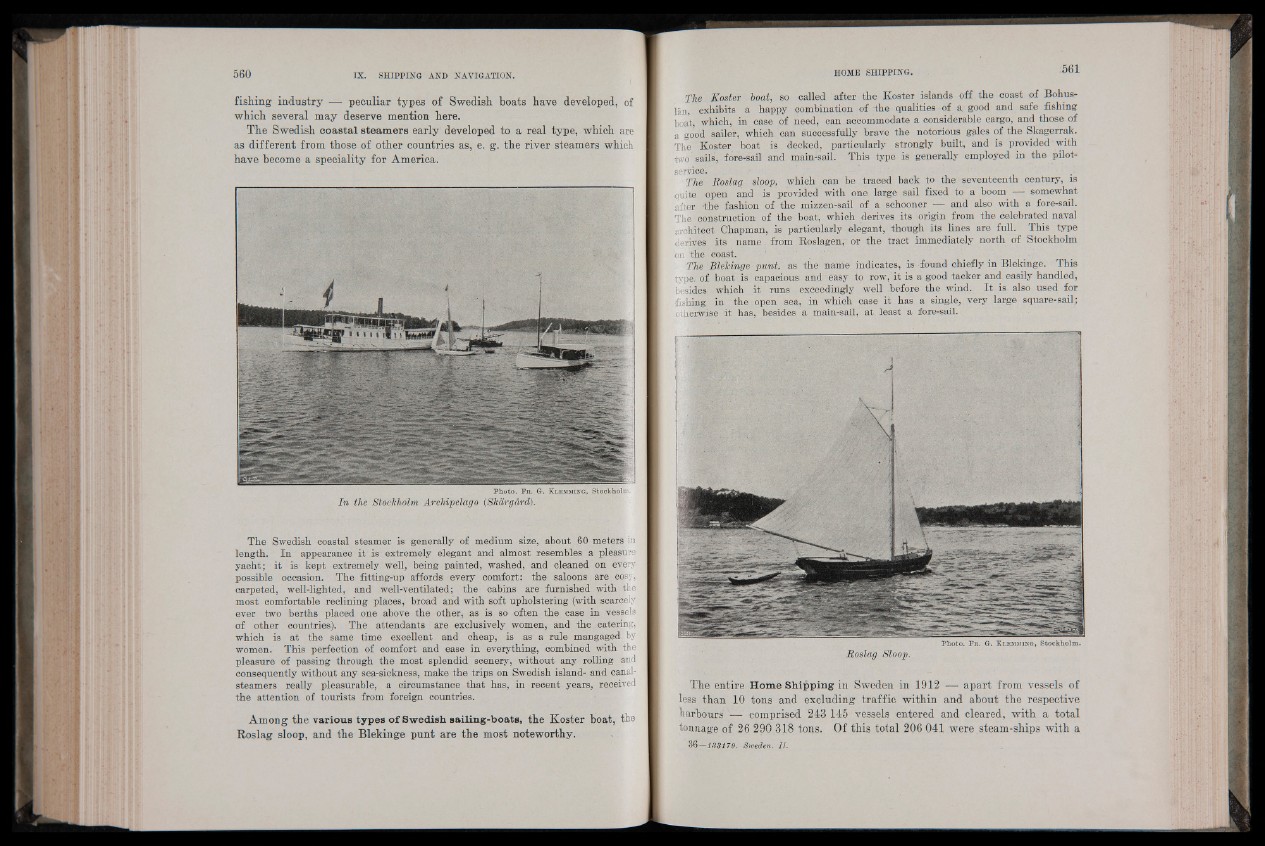
fishing industry — peculiar types of Swedish boats have developed, of
which several may deserve mention here.
The Swedish coastal steamers early developed to a real type, which are
as different from those of other countries as, e. g. the river steamers which
have become a speciality for America.
Pho to . F r . G. K l e m m in g , Stockholm.
In the Stockholm Archipelago (Skargârd).
The Swedish coastal steamer is generally of medium size, about 60 meters in
length. In appearance it is extremely elegant and almost resembles a pleasure
yacht; it is kept extremely well, being painted, washed, and cleaned on every
possible occasion. The fitting-up affords every comfort: the saloons are cosy,
carpeted, well-lighted, and well-ventilated; the cabins are furnished with the
most comfortable reclining places, broad and with soft upholstering (with scarcely
ever two berths placed one above the other, as is so often the case in vessels
of other countries). The attendants are exclusively women, and the catering,
which is at the same time excellent and cheap, is as a rule mangaged by
women. This perfection of comfort and ease in everything, combined with the
pleasure of passing through the most splendid scenery, without any rolling and
consequently without any sea-sickness, make the trips on Swedish island- and canal-
steamers really pleasurable, a circumstance that has, in recent years, received
the attention of tourists from foreign countries.
Among the various types o f Swedish sailing-boats, the Koster boat, the
Roslag sloop, and the Blekinge punt are the most noteworthy.
The Koster boat, so called after the Koster islands off the coast of Bohus-
lan, exhibits a happy combination of the qualities of a, good and safe fishing
boat, which, in case of need, can accommodate a considerable cargo, and those of
a good sailer, which can successfully brave the notorious gales of the Skagerrak.
The Koster boat is decked, particularly strongly built, and is provided with
¡wo' sails, fore-sail and main-sail. This type is generally employed in the pilotservice.
, - ' .•
The Roslag sloop, which can be traced back to the seventeenth century, is
quite ¿pen and is provided with one large sail fixed to a boom — somewhat
after th e fashion of the mizzen-sail of a schooner — and also with a fore-sail.
The construction of the boat, which derives its origin from the celebrated naval
architect Chapman, is particularly elegant, though its lines are full. This type
derives its name . from Roslagen, or the tract immediately north of Stockholm
bn the coast.
The Blekinge-punt, as the-name indicates, is found chiefly in Blekinge. This
type, of boat is capacious and easy to row, it is a good tacker and easily handled,
besides which it runs exceedingly well .before the wind. I t is- also used for
fishing in the open sea, in which case it has a single, very large square-sail;
otherwise it has, besides a main-sail, at least a fore-sail.
Roslag Sloop.
The entire Home Shipping in Sweden in 1912 — apart from vessels of
less than 10 tons and excluding traffic within and about the respective
harbours — comprised 243 145 vessels entered and cleared, with a total
tonnage of 26 290 318 tons. Of this total 206 041 were steam-ships with a
36—133179. Sweden. II.